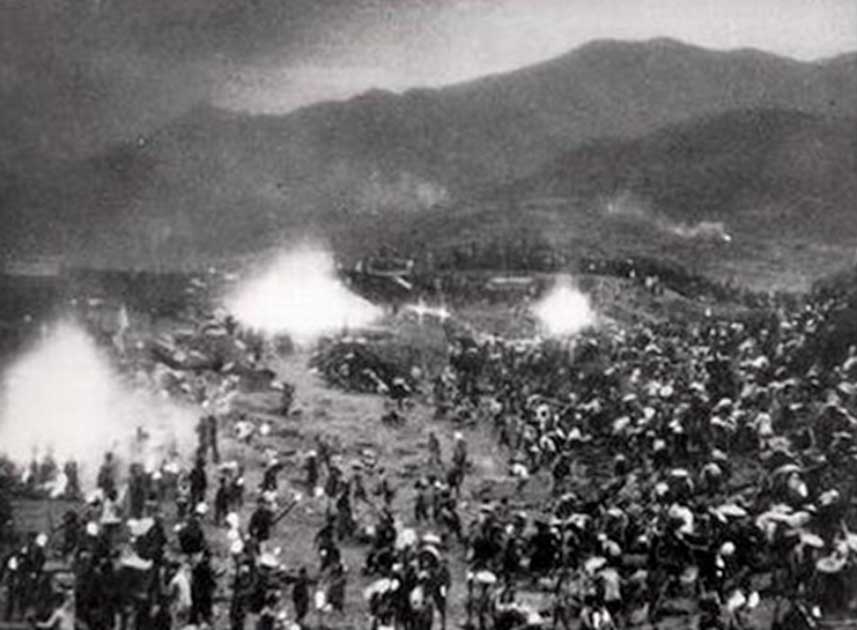In 1958 and 1962, the China communist party led its country through a transformative economic and social movement. Many things about the country changed very quickly, led by grassroots campaigns aimed at quickly developing the nation and bringing it to prominence on the world stage.
Among all of them, one of the most popular, and the most infamous, was named the “Four Pests Campaign”. Also named the Great Sparrow Campaign, Chairman Mao initiated this campaign to improve public hygiene.
It was initiated due to a perceived infestation of pests: the four targeted were rats, mosquitoes, flies and sparrows. These pests were identified because they spread diseases like typhoid, malaria, and bubonic plague.
The sparrows were particularly included in this list because they damaged agriculture by consuming rice and other seeds. This campaign was certainly well-intentioned, but it led to disaster.
The Four Pests Campaign
The Communist Party organized this four-pest campaign. This party surveyed Chinese rural citizens to find out what were considered the worst pests. Once they felt they knew what to do, the communist government published posters illustrating the need for public health, and awarded people tools like fly swatters, gongs, drums, and guns to fight these pests.
People were asked to follow all the improved health measures to kill pests. During this Four Pests Campaign movement, people mostly targeted the sparrows. To keep them away, the citizens were motivated to make noise through different instruments like pots, drums, and pans, which scared the sparrows, a measure so effective that they flew for so long they were seen to fall from the sky due to exhaustion and starvation.

In addition, the nests were torn to pieces, eggs were broken, and fledglings were killed, all for improved health. The campaign was a huge initial success, and sparrow populations across China plummeted.
- The Chinese Famines of 1907 and 1959: Natural Disasters or Man-Made?
- Thomas Jefferson and Sun Yat-Sen: Comparing Founding Fathers
All these actions were motivated by the government. The government motivated the citizens by organizing certain programs in schools, workplaces and government agencies regarding how to kill many pests with techniques.
Later at the end of the campaign, it was revealed that with the government’s and the public’s collaborative efforts, 1 billion sparrows, 1.5 billion rats, more than 220 million pounds (100 million kilos) of flies, and 24 million pounds (11 million kilos) of mosquitoes died. This was exactly what the government had hoped for.
Bounty Hunters
Part of the reason for the great success of the campaign was the bounties the government placed on the pests. Citizens who killed one of the animals could expect a financial reward, as well as the approval of the communist party, then as now very important in China.
Attempts were made to demonize the animals as well. During the Campaign, the government also said, “birds are public animals of capitalism.” After releasing this statement, the citizens started using the tools to create sounds by banging the pots and pans.
As a result, lots of sparrows died due to exhaustion. However, the citizens were also allowed to shoot the birds. These mass attacks by the citizens significantly decreased the pests and sparrows’ population.
Later, the government organized multiple contests in the government agencies, schools and enterprises. The rewards were given to those who killed the largest number of flies, rats, sparrows and mosquitoes. Fleeing the persecution, sparrows even flocked to foreign embassies in China, learning that they would not be attacked there. Beijing’s Polish embassy had to even formally refuse to allow the sparrows on their roof to be killed.
As a result, the embassy was surrounded by people handling drums. After making the constant drum sounds for days, the poles used shovels to attack the sparrows.
The Problem
The campaign may have been well-intentioned, and it may have been hugely popular, but it was also environmentally a catastrophe. The Chinese leadership had been advised by Soviet agriculture experts, whose policies were later completely discredited.
In April 1960, the Chinese leaders changed their opinion. An advisory ornithologist had pointed out that the sparrows ate a huge number of insects as well as the grain, and was in fact hugely beneficial to agriculture.

But by then it was too late, and the damage to the ecosystem through this thoughtless eradication was done. Rice yields decreased as swarms of locusts devastated entire harvests. Locusts are normally docile if kept isolated from each other, but absent predation from the sparrows their behavior changed and they made the situation far worse.
It is estimated that anywhere between 15 and 45 million people died of starvation as a result of the ecological catastrophe caused by the Four Pests Campaign. Originally intended to help the rural population of China, it ended up killing millions.
The Great Chinese Famine, a period between 1959 and 1961 where so many died due to starvation, was made far worse by the campaign. In some rural regions 20% of the population died, and far from developing the country the entire social structure fell apart.
To be sure, there were other causes of the great famine, not least a desire by the Chinese rulers to advance quickly and catch up with other world powers. Inefficient distribution of food to rural areas, other campaigns which encouraged farmers to leave their crops and focus on other endeavors such as iron production, were also to blame.
Corruption in the communist party also played a part, with grain surpluses being wildly overstated and leading to poor decision making and a lack of resources when they were most needed. But with the Four Pests Campaign, the destruction of the ecosystem led to the worse famine in human history.
Top Image: Poster promoting the Four Pests Campaign. Source: China government / Public Domain; Aliaksandr Marko / Adobe Stock.
By Bipin Dimri